“History isn’t about dates and places and wars. It’s about the people who fill the spaces between them.”
― Jodi Picoult
They were one of the first things I noticed about Girona—in a sea of new images, sounds, and street names, the fountains stood out.
You could easily miss them as you walk down the labyrinthine streets of the city’s old quarter, where creperies and boutique clothing shops and riverside cafés all vie for your attention. But every so often, you’ll come across a narrow, unassuming fountain situated between two storefronts, with a deep, hollow space to lean into and procure a sip from.
There was one fountain in particular that I kept passing on my first day in Girona, on a street called the Carrer de L’Argenteria. A metal sculpture of two interwoven fish had been placed over the spigot, and just above the pair, inscribed onto a small round stone plaque, was the year of its construction: 1858.
I wish I could tell you why I was so drawn to the scene, but I think it had something to do with having the year there—and with the way that both the bookstore to the fountain’s right and the jewelers on its left had also displayed the years in which they were established, both in the late 1800s. It was as though the street itself was a visual timeline of the city, and every year displayed was another point in history.
When I look back on the sketch now after spending two weeks in Girona, it seems almost quaint that I was so charmed by these references to the 19th century. For if the history of the city were an ocean, as I sat on the Carrer de L’Argenteria that first afternoon I was most definitely standing in the shallows, ignorant of just how deep Girona’s story goes.
As it always does in a new place, it took time for me to wade in beyond the shore.
* * *
Not long after I arrived, I had the opportunity to have a guided walk of Girona’s old quarter. The city council kindly arranged this for me, and so it was that three days after completing that first fountain sketch, I met up with Anna Aliu, a longtime resident of the city and guide for thirty years.
My morning with Anna was a welcome crash course in Girona’s history, taking in cathedrals, cloisters, Arab baths, and Romanesque churches. I made a note in my journal of many of the places we visited, reminding myself to come back later and linger—and that’s exactly what I tried to do over the following two weeks.
I returned to the Museum of Jewish History, located inside the Call—or what the medieval Jewish Quarter of the city is known as in Catalan. Anna had explained that there was a significant Jewish community in Girona for some 600 years—at times, amounting to even ten percent of the city’s population—and that these families were merchants and craftsmen, philosophers and poets.
From what I’ve read (and I especially recommend this post by writer Pam Mandel), the Jews in Girona were never fully free from discrimination in a predominantly Catholic society, but the Edict of Expulsion issued by Ferdinand and Isabella in 1492 was the final, tragic step that forced them out of the city. Along with a research library on-site, the museum exists today to tell their story, one that had lain silent for far too long.
I returned to the windswept walls that surround the old town—known in Catalan as the Passeig de la Muralla and dating to the 14th century (although some sections were built far earlier). On a blustery Sunday afternoon, I sat sketching atop one of the wall’s towers, positively shivering from the cold but loving the sweeping vantage point my little nook offered me over the city—and seemingly over time itself.
And on my final full day in the city, I returned to a place outside town called Empúries, which I had visited with my friend Jaume Marin at the start of my stay in Girona. This time, we returned with his family for a rather lovely Sunday picnic at the beach, but I briefly snuck away at one point and started a sketch on-location. My subject? The remains of a port built by Greek colonists in the 6th century BC, when they founded Empúries as an important trading settlement.
I hadn’t known such ancient history could be found in Girona. But the more I read, the more I learned that the arrival of the Greeks and Romans and Phoenicians was only the beginning; in the ensuing centuries, there’s hardly a key figure in history who didn’t pass through the Costa Brava—Charlemagne, Napoleon, the Moors—just as there’s hardly a style of architecture that isn’t represented by at least one building in Girona.
I thought about just how far I’d come in two weeks—from sketching a 19th century fountain to one of the first Greek ports built on the Iberian Peninsula, something that actually requires the letters BC to follow its year of construction. And it was then that I remembered something Anna had said while we were visiting the Arab Baths.
It had been a process, a slow journey of discovery, but even as I sat there on the edge of the Mediterranean, I knew my understanding of this region had finally moved beyond the shallows. Anna was right:
“The deeper you go, the more you find.”
* * *
It was while I was sketching on the walls that breezy afternoon that a group of young Israeli men climbed up the round staircase leading to the top of the tower. They followed the pattern I’d observed in many visitors during the hours I’d spent there—the initial gasps for air after a steep climb up the wall; the awed exclamations over the expansive view before them; and the many photos snapped of themselves and the city.
After a few minutes, one of the guys approached me; I could see his hesitant steps out of the corner of my eye.
“Excuse me,” he said, “but what is this place?”
I was struck by the simplicity and complexity that coexist in such a question. I tried to helpfully relay some of the information that Anna had given me about the walls, and then I kept thinking after they left. Because in just four words—what is this place?—he had nailed one of the core questions we ask everywhere we visit.
As travelers, our time in a new city is never enough to fully understand it—in fact, it seems almost unfair, doesn’t it?—but still we seek to plumb its depths and ask:
What is this place?
What was this place?
And in a town like Girona, where there’s such a debate currently taking place over the region’s future, and where Catalan independence flags hang from so many wrought-iron balconies, their red and yellow stripes bright against the city’s soft-colored stones, you find yourself asking one final iteration of the question—what will this place become?
Here in Catalonia, it seemed all the more important—vital, even—to understand Girona’s past before I could begin to imagine its path forward.
Disclosure: I’m incredibly grateful to be here in Costa Brava for six weeks as an artist-in-residence with the fantastic team at Visit Costa Brava. The tourism board is kindly assisting with accommodation and food costs, allowing me to devote my stay here to bringing this region to life in words and sketches.

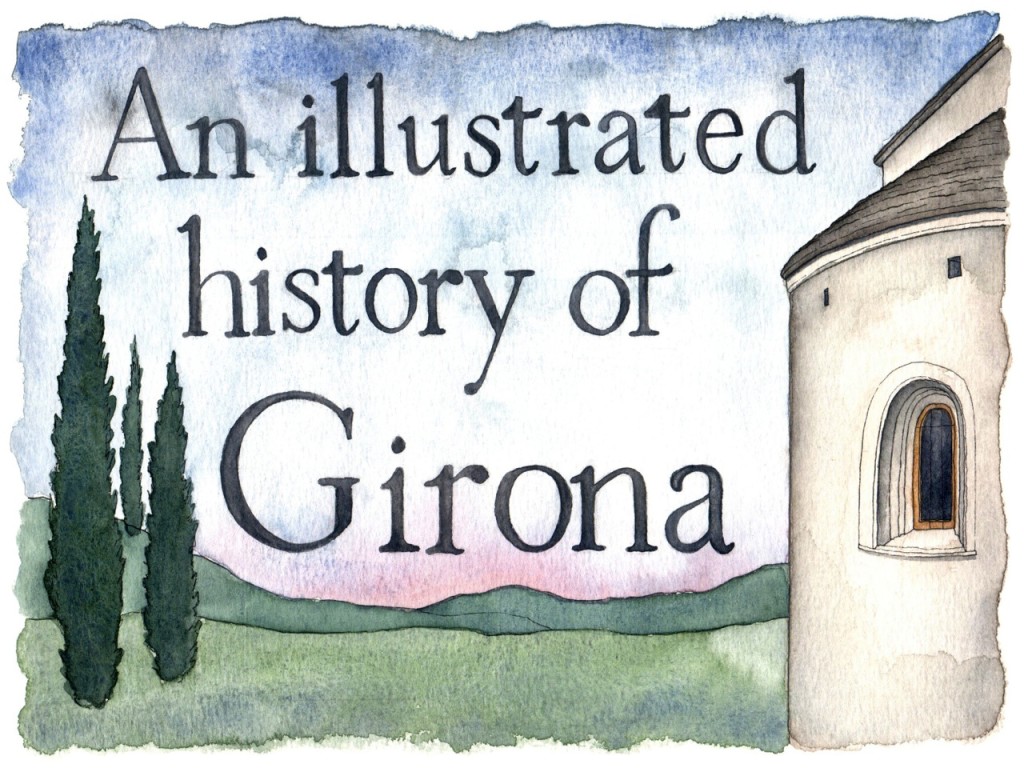
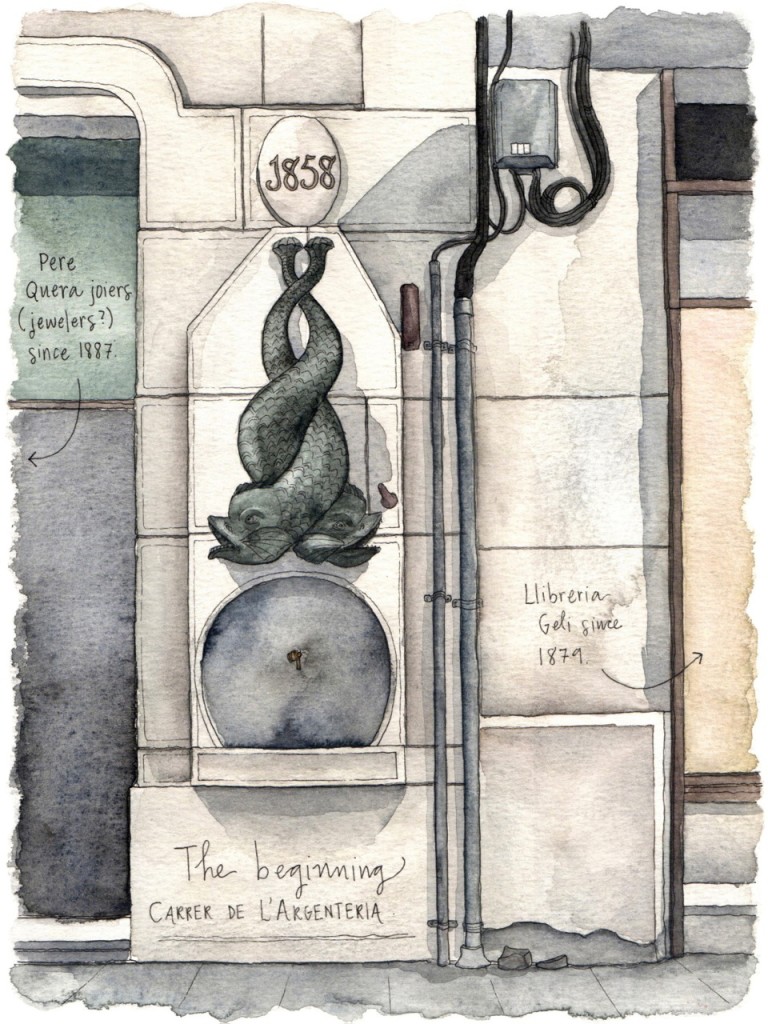
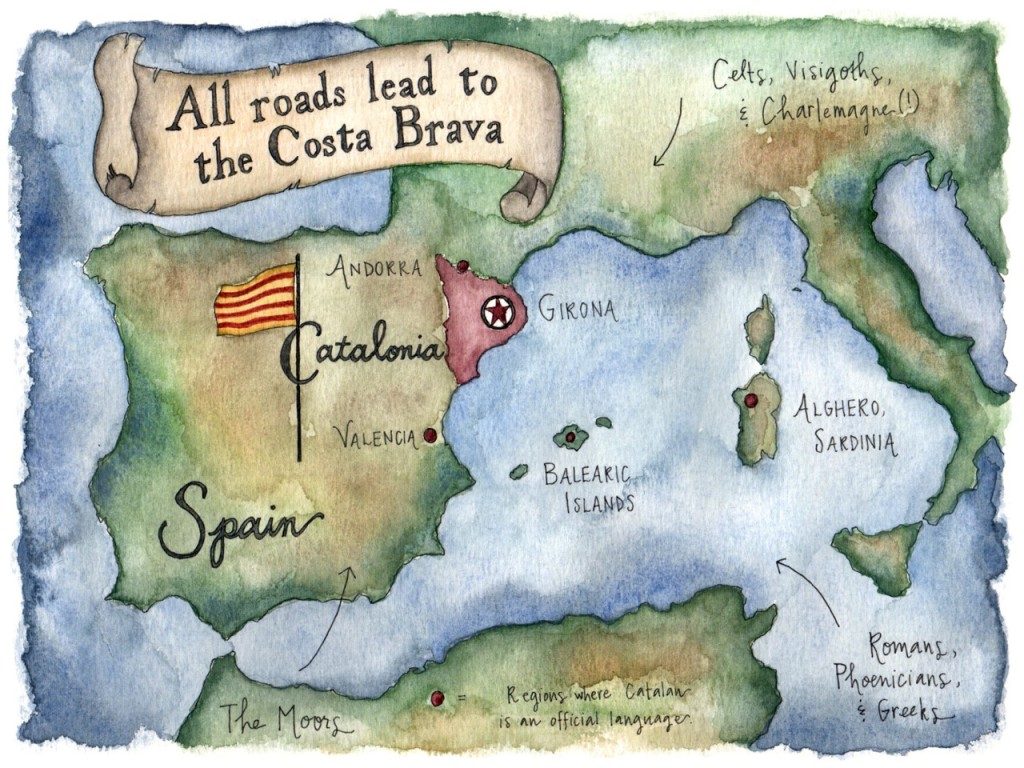
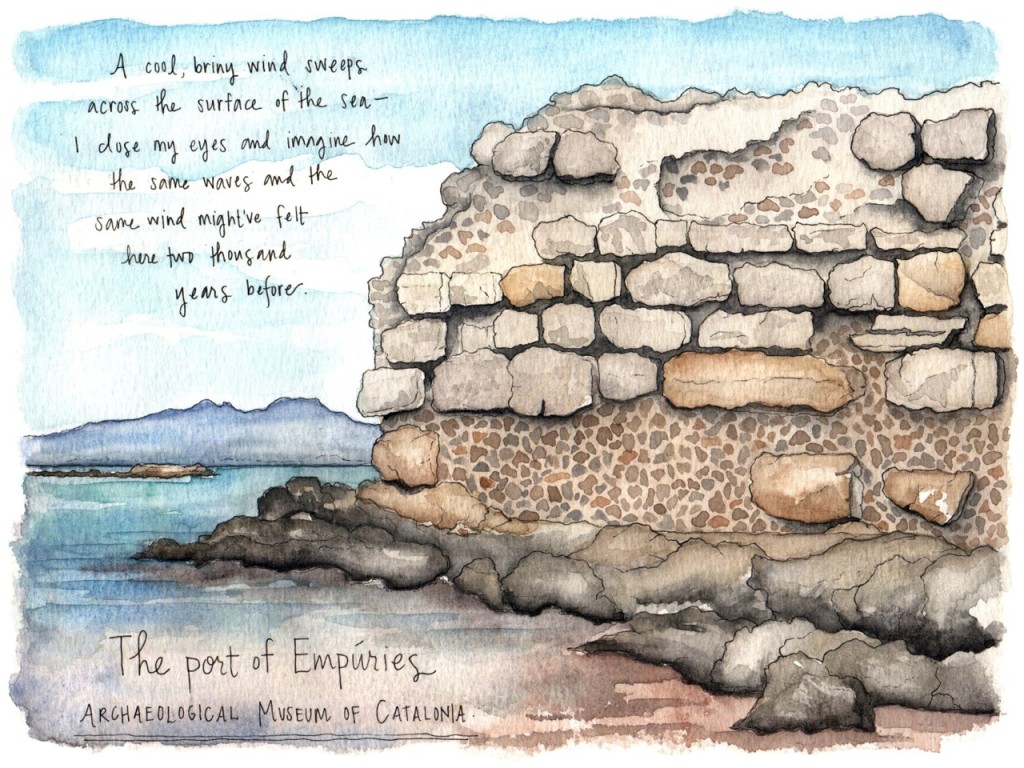
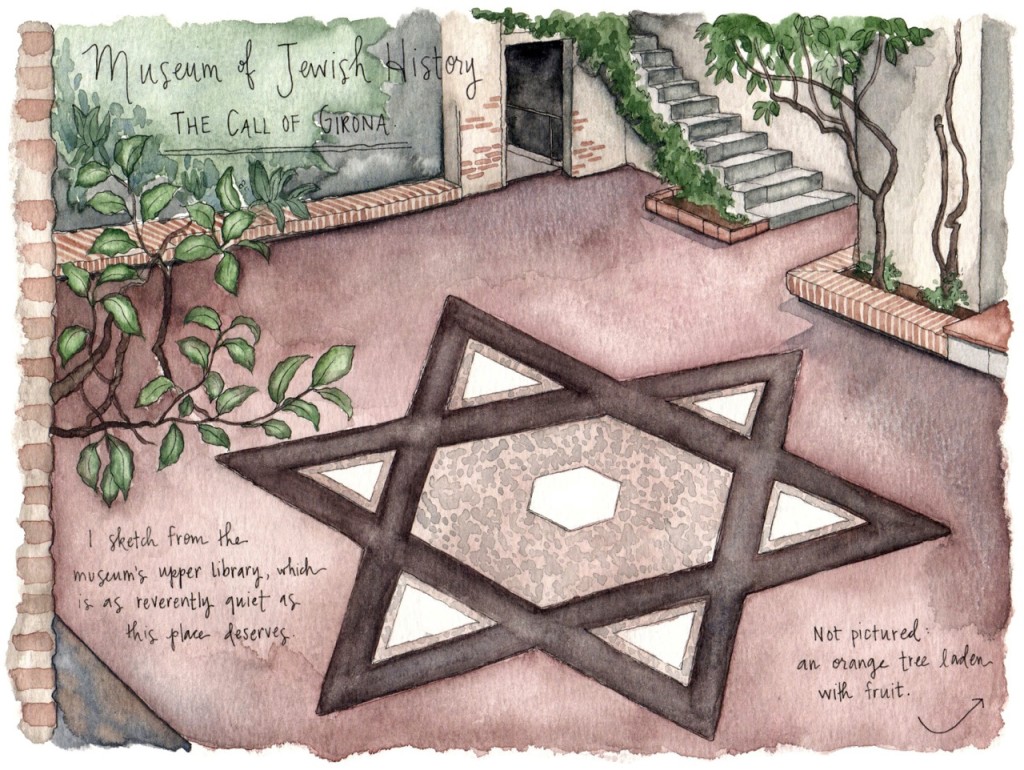
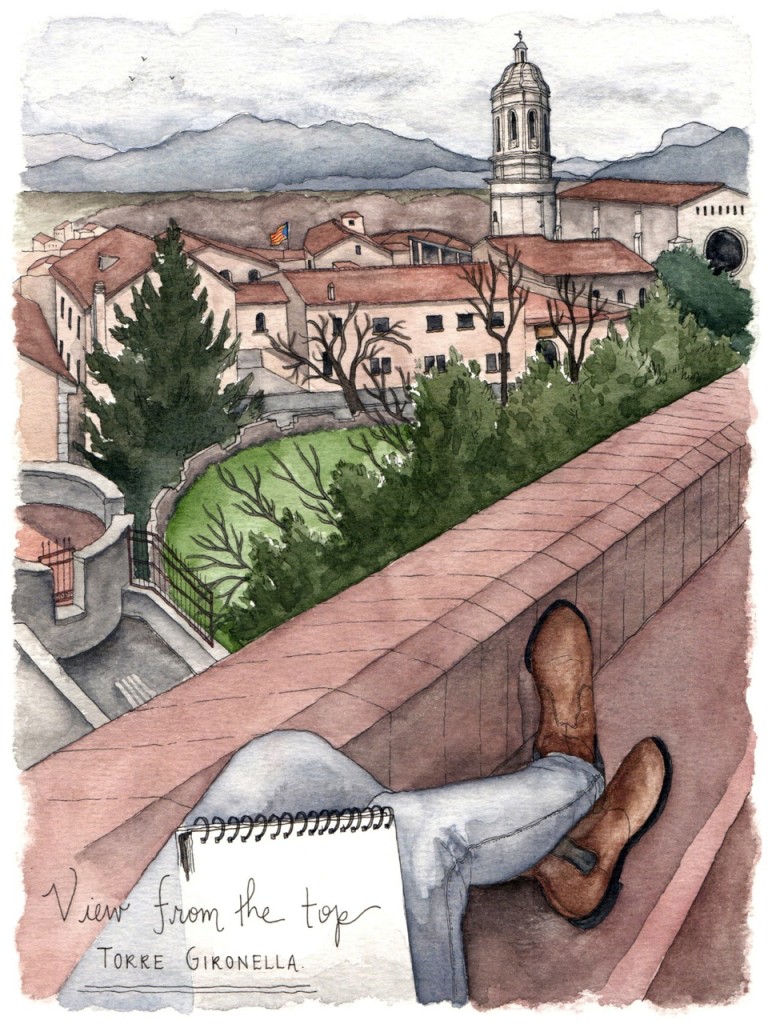
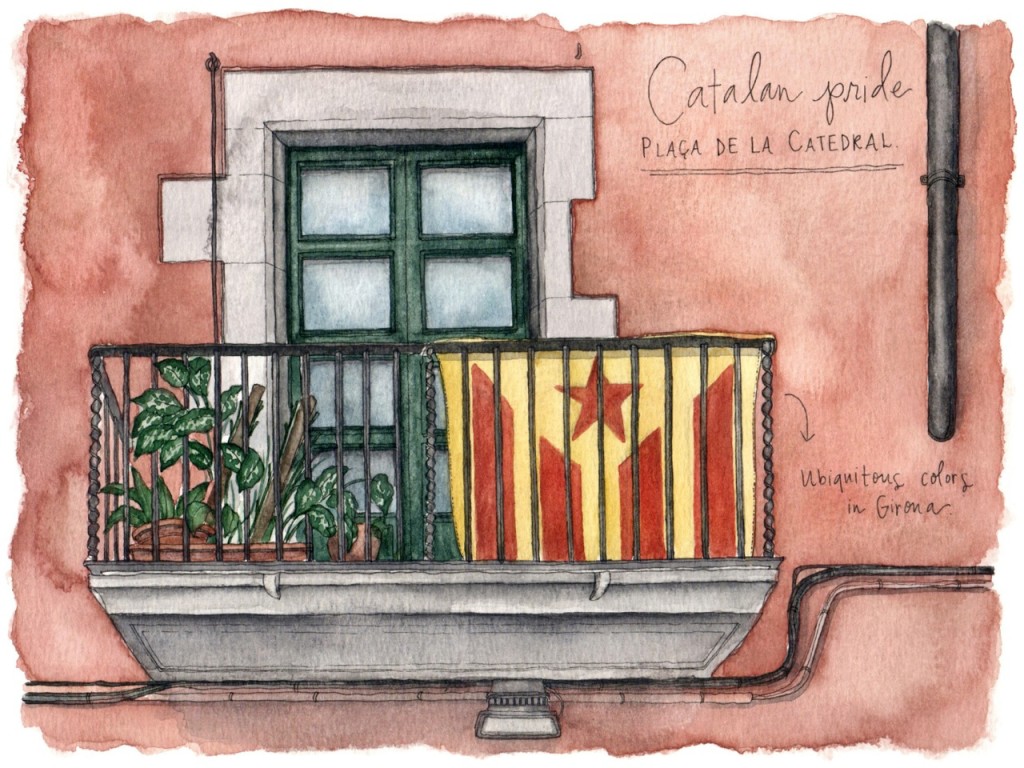

Well, there you go again, brilliantly bringing your surroundings to the rest of us through story and wonderful visuals. Your sketches are knocking me out! And the Visit Costa Brava team must be wearing out their arms patting themselves on the back for getting you there.
Thank you so much, Nancy! What a wonderful gift your comment was – I’m thrilled to hear you’re enjoying the Costa Brava sketches 🙂 And I’m incredibly grateful that the team I’ve been working with here does indeed seem to be happy with the sketches so far – it’s truly a dream partnership!
As I discover another European city for the first time – Istanbul – I find myself thinking of you and what you would see and sketch if you were here. It makes me wonder: What makes you stop in a place and sketch it? What draws you to one scene over another? Is it a comfortable seat? A beautiful view? An interesting angle? Or can it not be explained, but only felt in that moment? Just curious! 🙂
Brittany! I LOVE love love that you’re in Istanbul right now (which reminds me that I need to reply to your wonderful email asap!) – it’s one of my favorite cities in the world and I can’t wait to hear what you think of it. I also loved your questions about what draws me to a particular scene, and have to say that it’s truly a combination of all of the above 🙂
Some days I set out with a specific subject in mind, other days I’m fairly open to what strikes me as I wander around – and you’re so right…the issue of where to sit or perch while I sketch is forever a consideration as well!
The bottom line for me is that there has to be something pulling me to that spot for me to draw there…it might be the tiniest thing (for instance, today I simply loved the striped tablecloths at a little seaside cafe), but that still serves as a spark to help me bring the scene to life. Thanks so much for asking, and ENJOY ISTANBUL! xo
LOVE this post! The way you’ve brought the stories of a place to life with your sketches has inspired me to pick up my sketchbook again. Can’t wait to read your next post
Genevieve
Thank you so much, Genevieve! It made my night to hear you’ve been inspired to pick up your sketchbook again – enjoy! 🙂
Lovely, as usual. You brought the history of the region to life with both words and your drawings! Thanks for sharing.
Thank you for reading and saying hello, Rhonda! It’s been a great few weeks getting to sketch here along the Costa Brava so far, so I’m so happy to hear you’re enjoying the stories! xo
Beautifully written Candace!! It’s always so interesting the longer you explore a place how different your initial assumptions about it become. I’m currently in the Middle East and I doubt I’ll ever come close to understanding all the intricacies of the different religions and the roles they played throughout history. You’ve now made me add Girona to my travel list!!
Thank you so much, Kristine! I’m so glad this post resonated with you and that it might have even connected with where you’re currently traveling – I can only imagine how many different layers of history there are to discover in the Middle East, and hope you have a safe, enriching journey during your time there!
Beautiful post! Can’t wait to head down there for TBEX in a few weeks!
Thank you, Stephanie! Looking forward to meeting you at TBEX 🙂
So glad you are enjoying Girona! I spent 4 days there last
September and loved it, especially those arched, stepped alleyways! I would
encourage you to read the historical mystery series by Caroline Roe/Medora
Sale, featuring Isaac of Girona and set in the 1300s–these books are what drew
me to the city. They’re not on Kindle but you can find plenty of paperbacks
when you return to the US. I can’t wait to see more of your Girona paintings!
Those little stepped alleyways were my favorite motif from the city as well! And thank you so much for the reading recommendation – perfectly enough I’ve got that series written down on my list, but as you pointed out, I haven’t been able to check them out yet on my Kindle 🙂 Glad to hear you enjoyed them, Kate!
In a world that is swamped with photographic imagery it’s lovely to see a place through more thoughtful eyes. And also the opportunities it is opening up for you. It’s very inspiring. I know the time that goes into each of these sketches and somehow that slow lens of yours reveals so much more. Lovely piece Candace. Really makes me want to explore Girona. Enjoy this time.
When I arrived in Girona nearly two weeks ago, I didn’t know what to do but now my all problem get solved…